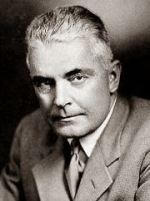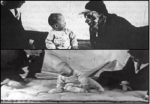
 Can humans also be conditioned just like the dog in Ivan Pavlov’s experiments? Intuitively, it looks like humans can be conditioned, but nothing much was known about the same until behaviorist John B Watson’s infamous ridiculously ‘novel’ experiment on a human infant!
Can humans also be conditioned just like the dog in Ivan Pavlov’s experiments? Intuitively, it looks like humans can be conditioned, but nothing much was known about the same until behaviorist John B Watson’s infamous ridiculously ‘novel’ experiment on a human infant!

The “Little Albert” experiment is a famous experiment conducted by John B Watson and his graduate student Rosalie Rayner, which set the platform for behaviorism in the field of psychology. Watson proposed that the human psychology can be explained by the process of classical conditioning. The way a human being responds to certain kinds of stimuli are all a process of learning which has occurred in one’s life. He simplified the human nature into a stimulus – response relationship and removed mind and consciousness from the equation and he went forward to put forth his belief that ‘learning’ by different individuals, is the main reason why each and every person is different. Human beings as infants are like unmolded thermoplastic material which gets molded and shaped differently with learning that determines a person’s. Learning can be intervened at the stage of infancy and one can create different learning situations which would mold the baby into a specific type of person.
He is famous for his quote:
“Give me a dozen healthy infants, well-formed, and my own specified world to bring them up in and I’ll guarantee to take any one at random and train him to become any type of specialist I might select – doctor, lawyer, artist, merchant-chief and, yes, even beggar-man and thief, regardless of his talents, penchants, tendencies, abilities, vocations and the race of his ancestors”. (Watson, 1924, p. 104)
John B Watson received his PhD in Psychology in 1903 and went on to teach psychology at Johns Hopkins University in 1908. He and his graduate student Rosalie Rayner joined to design an experiment to test, rather prove his belief about learning shaping the identity of a human being. In 1920, an infant referred to as Albert .B, son of a wet nurse working in Harriet lane home for invalid children, a hospital attached to the Johns Hopkins University, where Watson was teaching was employed as a sole subject for the experiment. In his paper – “Conditioned emotional reaction, John B. Watson and Rosalie Rayner (1920) Journal of Experimental Psychology, 3(1), 1-14.”, Watson had assessed the infant first at 8 months and 26 days of age and had mentioned that the infant was “healthy from birth and one of the best developed youngsters ever brought to the hospital”. At this point my mind goes a bit off track and reads this very sentence again! Does it mean that there were other innocent infants which were brought in for psychological studies being conducted in this institution? What could have been the other experiments? Whatever happened to those children later? It gives me chills to even think about what scientists could have done at that point in time when there was minimal or nil ethical awareness. Going back to the story, the baby was described as being impassive and unemotional. The authors mention that the stability of the infant made him a candidate for the experiment because they thought that for a stolid infant like “Little Albert” how much harm can a simple conditioning experiment do? I am in a fix here, the authors say that the infant was nonchalant and that’s one main reason for them to have the infant as their subject. 9 month old infants are quite active, they laugh, they make funny sounds, and they crawl pretty fast. At this stage they have separation and stranger anxiety set in. But Little Albert never showed signs of stranger anxiety when dog, monkey, rat or a rabbit was brought in, during the preconditioning period. He remained stolid which was unusual. Why did Watson and his graduate not notice this change in behavioral pattern of this infant compared to the majority of infants? Instead Watson claimed that this unemotional behavior was more like a bonus for the study because he thought that there was little harm for the infant.
In conditioning experiments there is a pre-conditioning period during which the infant is exposed to different stimuli – monkey, dog, rabbit, with masks with and without hair, burning newspapers, cotton wool etc. The first responses (a change in behavior) was recorded. The child did not show any fear neither did it ever cry (which was confirmed by the child’s mother and other hospital attendees during the time of the experiment). The preconditioning went on up to 9 months of age. At 8 months and 26 days the experimenters made a loud sound by striking a hammer to a suspended steel bar behind the infant. With the first strike the baby was disturbed, he started flailing his arms, with the second strike he trembled and with the third he started crying which was the first time he ever cried.
At 11 months of age, the baby was experimented for the conditioning of the stimulus. Lab rat was presented to the child before the experiment and just when it was about to reach for it the loud noise was made and the child started crying and never reached for the rat again. The baby has now been conditioned and on further experimentation it proved that the baby associated the white lab rat with the loud noise which scared him. The authors wanted to know if there was a transfer of this fear into objects with similar characteristics. They looked at the response of the infants towards coats, white fur, dogs etc. and the infant responded by withdrawing , crawling away from the stimulus or crying which confirmed the generalization hypothesis. They conducted similar experiment after almost a year to know about the duration of this “learned fear”. From their results it looked like the fear that had been developed towards white fur, small sized animals has been imprinted for a long time now.
The child was moved out from the hospital and the authors did not have any ways to have the child for reconditioning experiments to remove the fear that they had seeded.
Whatever happened to little Albert was not known until this mystery was solved in 2010 by Hall .P. Beck, a psychologist at The Appalachian State University. After 7 years of search Beck and his students found out the truth about the child. Douglas Merritte was the baby boy of a wet nurse, Arvilla Merritte who worked at the pediatric hospital and lived on campus where the experiment was being conducted. She received $1 for the study which had her infant as the subject!! I am trying to think of the situation she was put in – She was a wet nurse who depended completely on the hospital for her and her baby’s living. What was running through her mind when the experimenters asked her baby to be used as a subject for their study? Was there a voluntary informed consent obtained from her? Was she ever told about the planned experiments, the need and the pros and cons of the study? Will a mother let scientists induce fear in her child? When I put myself in her shoes I find it extremely disconcerting to make a decision because I am completely dependent on the hospital for my living and my child’s welfare and when the hospital is asking my help I am obliged to do what they say. What if they fire me from my job if I don’t agree to what they say? Wet nurses were often thought to be a part of the low strata in the society. Vulnerable people like this wet nurse or the naive people of Macon County (Tuskegee study) are easy targets for several studies where the experimenters use them as lab rats!
Watson has documented that as soon as the conditioning experiments were over the child was moved out of the hospital and therefore the effects of a planned reconditioning experiment could never be studied.
Beck and his students pursued their search for the identity of baby Albert and with the help of facial recognition experts found Douglas Merritte and Arvilla Merritte whose characteristics matched with almost everything which was documented by Watson and Beck published a paper on this in 2009. Beck reported that the child died at the age of 6 because of an acquired hydrocephalus. Alan Fridlund, a psychologist working at University of California, Santa Barbara stumbled upon the most important detail of the story. Douglas Merritte had an attack of meningitis in 1922 and died of hydrocephalus (as a result of meningitis) in 1925. This information did not fit in well considering the pathophysiology of meningitis. If the meningitis was so severe that it lead to hydrocephalus then it is quite unlikely that the child could have survived for such a long time. Fridlund investigated the tapes recorded during the experiment and felt that the baby was alarmingly stolid with the initial confrontation of a dog, monkey, rabbit etc. which indicated that the child is not normal and might be suffering from some neurological issues or very poor vision. His finding was confirmed further by William D.Goldie, an associate professor of neurology in University of California at Los Angeles who thought that the child might even be autistic but definitely the child was not normal.
With the help of Gary Irons, nephew of Douglas Merritte his old medical records were gathered which indicated that the child was not normal. At 6 weeks of age it had a staring expression, unusual hyperactive reflexes. Apparently, Douglas Merritte aka Little Albert had congenital hydrocephalus (at 1919, before Watson’s experiment) and multiple hospital procedures were done on the baby to understand what was wrong. In a report it is also mentioned that the meningitis that the baby contracted could have an iatrogenic origin may be because of improper sterilization of surgical instruments or surgical wounds etc. So the baby was never a representation of the general population of human infants!! Did Watson know about this? Did he use this baby just because he was of the right age , born to a vulnerable wet nurse who would be obliged to let her child be a subject to a cruel experiment ? If Watson knew about the neurological disorder of the child why would he conduct an experiment might not be the right model for the generalized population? Did he deliberately misinterpret the child’s behavior?
There are so many unanswered questions about the feasibility and the application of the results of the experiment conducted by Watson and Rayner. The whole study looks highly unethical to me. First of all , a wet nurse working at the institution was targeted who would 99.99% obey and agree to what she is being told, secondly a questionable voluntary informed consent, thirdly a baby with neurological disorder was used as a subject which did not represent the general population of human infants fourthly a possibility of deliberate misapprehension of results – all these possibilities points to the power the scientists had during the early 1900s to conduct experiments on vulnerable population. This is definitely a sad period of science growth. On the brighter side there are ethical rules and regulations which was set as a result of earlier studies that keeps the scientists at bay from conducting delirious experiments.
Recorded video of little Albert during the experiment :
